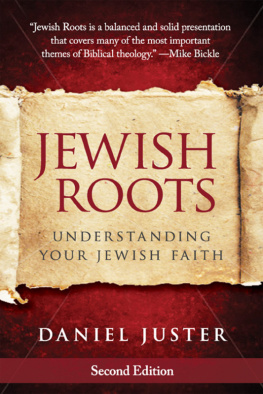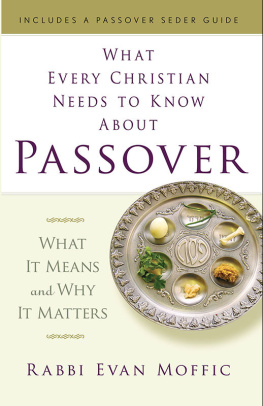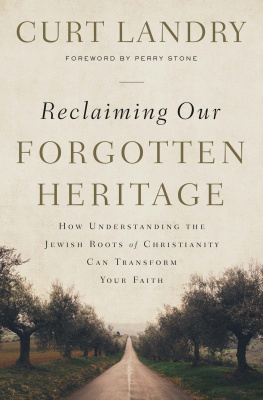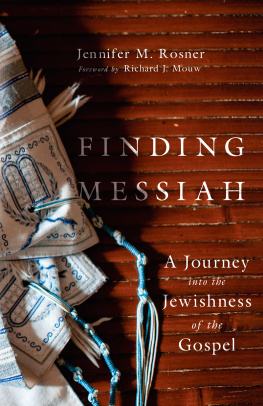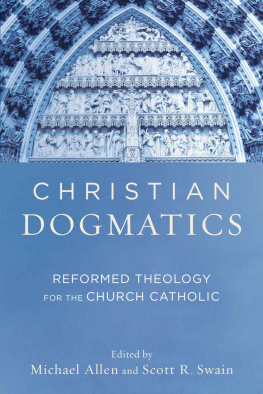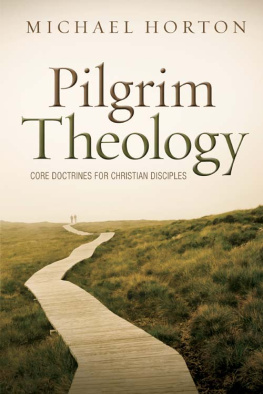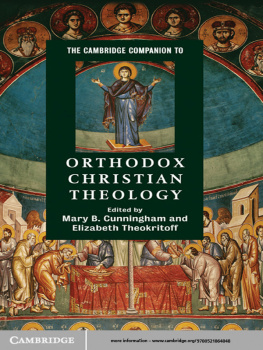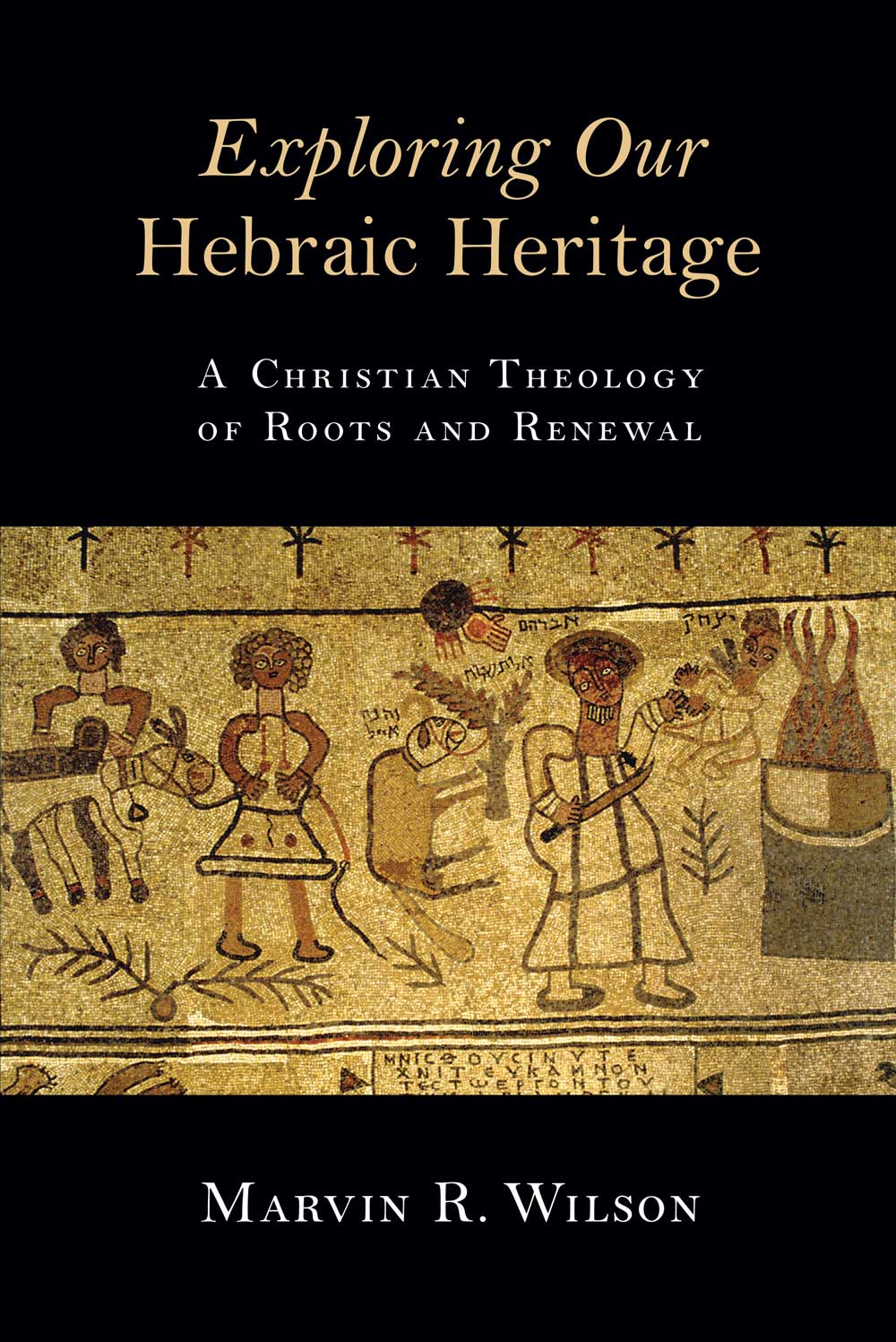2014 Marvin R. Wilson
All rights reserved
Published 2014 by
Wm. B. Eerdmans Publishing Co.
2140 Oak Industrial Drive N.E., Grand Rapids, Michigan 49505 /
P.O. Box 163, Cambridge CB3 9PU U.K.
Printed in the United States of America
Library of Congress Cataloging-in-Publication Data
Wilson, Marvin R., 1935
Exploring our Hebraic heritage: a Christian theology of roots and renewal /
Marvin R. Wilson.
pages cm
Includes bibliographical references and index.
ISBN 978-0-8028-7145-9 (pbk.: alk. paper)
eISBN 978-1-4674-4231-2 (ePub)
eISBN 978-1-4674-4197-1 (Kindle)
1. Christianity Origin.
2. Church history Primitive and early church, ca. 30-600.
3. Judaism (Christian theology) History.
I. Title.
BR129.W55 2014
261.26 dc23
2014005078
www.eerdmans.com
Contents
Dedicated in remembrance of the life of
Dwight A. Pryor
Cherished friend and humble servant,
Beloved scholar-teacher of our Hebraic heritage,
Man of deep faith who first implanted the vision of this book.
May his memory ever remain a blessing.
As any one of Marvin Wilsons countless students could tell you, the treasury of learning, insight, and wisdom found in this book emerges from a lifetime of integrity and faithfulness. This long-awaited sequel immediately takes its place alongside his bestselling Our Father Abraham as mandatory reading for all who participate in our educational programs.
James C. Whitman
president of Center for
Judaic-Christian Studies
Wilsons Exploring Our Hebraic Heritage shows how Judaism and Christianity can mutually enrich our faith communities despite the great tragedies of the past.... Offers a wonderful resource for any rabbi or minister wishing to better understand how Jesus ethical teachings fit within the context of early rabbinical tradition and theology.
Rabbi Michael Leo Samuel
author of A Shepherds Song: Psalm 23 and the Shepherd Metaphor in Jewish Thought
Cut off from its Jewish roots, Western Christianity has lost its way and its credibility.... Faith in Jesus need not, and indeed must not, obliterate the (Jewish) faith of Jesus. Wilsons book points the way toward authentic Christian renewal.
David N. Bivin
editor of JerusalemPerspective.com
Exploring Our Hebraic Heritage
A Christian Theology of Roots and Renewal
Marvin R. Wilson
William B. Eerdmans Publishing Company
Grand Rapids, Michigan / Cambridge, U.K.
Vowels
a as in father (dabar, shalom, lappidim)
e as in red (ha-zeh, mishteh)
i as in machine (li, dodi)
o as in cold (torah, kenegdo, zimrot)
u as in tune (ketubah, nissuin, galut)
Consonants
represents the harsh guttural sound of Hebrew et (yi us, mishpha ah, or im, okhmah)
kh represents the spirantized sound of Hebrew kaph as in the German word Bach (shadkhan, hakhnasat)
tz represents the Hebrew tsadhe (mitzvah, matzot)
b after a vowel is pronounced v (dabar, ketubah)
represents the separation of sounds of Hebrew aleph (nebiim, nissuin)
represents the separation of sounds of Hebrew ayin (daat, me at)
Hyphen
-the hyphen in Hebrew words is a grammatical indicator to separate an article from the word that follows (ha-zeh, ha-ba), or an indicator that connects the conjunction and to the word that follows (ve-nit azeq, u-sheon, ve-hagita)
Christianitys Hebraic heritage is multifaceted and rich. For years, I have reminded my students that Christianity was not invented out of whole cloth, nor did it originate de novo; instead, it was a development from Judaism. To understand anything of the depth of biblical Christianity and its teachings one must understand Judaism. This is sometimes particularly difficult for Christians living in the Western world to grasp. Throughout our history, we have tended to be influenced more by Greek and Latin expressions of Christianity than by those of the Semitic world of the East.
The history of Christian-Jewish relations mainly chronicles a troubled past. Although originally the first-century church had sturdy Jewish roots, by the middle of the second century and the parting of the way many of those vibrant roots were beginning to rot, wither, or die. Instead of thriving with its (Jewish) olive tree connection (Rom. 11:18), within a century especially outside the land of Israel throughout the Mediterranean world the church was less and less Jewish in its composition, influence, and expression and more and more had developed religious patterns and practices reflective of the wider culture of the day. The de-Judaization of the church would have lasting effects on the history, teachings, and practices of Christianity.
Let us briefly highlight some of the important developments that brought change to the church. The church began as a movement totally within Judaism, enjoying the favor of all the people (Acts 2:47). For the first twenty years of the early church up until the middle of the first century unless someone was born a Jew or had chosen to convert to Judaism (a proselyte), that individual was excluded from the church. Like a number of first-century Jewish sects or parties, such as the Pharisees, Sadducees, and Essenes, the early Jewish followers of Jesus, the sect of the Nazarenes, were another expression among the various Judaisms of the day (see Acts 24:5).
In a.d. 49, the Council of Jerusalem was called (see Acts 15). The Jewish apostles and church leaders wanted to find a way for those outside the commonwealth of Israel to share in the heritage of the ancient people of God. Belief in Jesus and in the apostolic witness about him became the criterion for membership within the fledgling Jewish church. As the gospel message began to spread rapidly outside the land of Israel, many Gentiles responded to the gospel message and joined Jews as those newly grafted into the olive tree (see Rom. 11:17-24). But unlike Jews, the physical descendants of Abraham who bore the sign of the covenant in their flesh (see Gen. 17:13), Gentile believers did not have to undergo the painful rite of circumcision. Further, Gentiles were not obligated to perform the hundreds of commandments of Judaism, many of which were intended to set the Jewish people apart from the nations.
By the second century, with the rapid advancement of Christianity into the non-Jewish world, an adversarial relationship had begun to develop between church and synagogue. As the number of Gentiles quickly grew within the church, Gentile leadership of the church grew correspondingly. This gradually led to the emergence of an anti-Jewish polemic accompanied by a spirit of triumphalism, arrogance, and outward hostility. Jews were increasingly viewed as those of a dead and legalistic religion, cursed by God for their rejection of Jesus.
Christianity became more and more de-Judaized in expression. The Septuagint or Greek version of the Hebrew Bible was a factor in hastening this process. The de-Judaization of early Christianity was likewise aided and abetted by a number of influential early church fathers who brought certain neo-Platonic teachings and philosophical constructs into early Christian thought. The rise of various branches of Gnosticism, with their spiritual and esoteric teachings, also brought a corrupting influence upon the flesh and blood emphasis that early Jewish Christianity had inherited from Judaism.
Conflict also arose over various theological issues. Differing points of view arose concerning Jesus and claims about his messiahship, divinity, and resurrection. Further, many traditional Jews, upon realization that Gentiles were not required to keep all the Law of Moses including circumcision, Sabbath worship, and dietary regulations considered such religious negation the very evisceration of Judaism. The interpretation of such actions was that these people have left Judaism. Indeed, in the beginning, the modification of the practice of Jewish Law through the exempting of Gentiles from various Jewish commandments probably created as much discord between communities as theological disagreement did, if not more. Adding further to the controversy, Gentile believers saw the church as the new Israel, replacing Jews the old Israel. This teaching of supersessionism was picked up by the middle of the second century in the writings of Justin Martyr.



